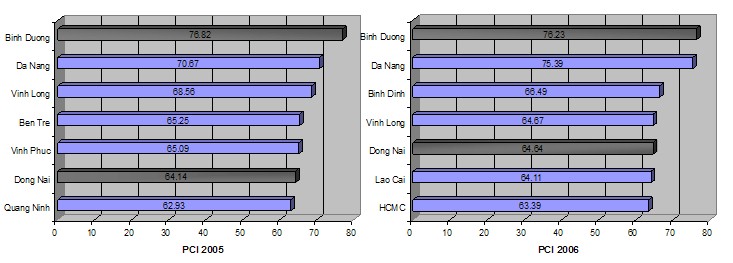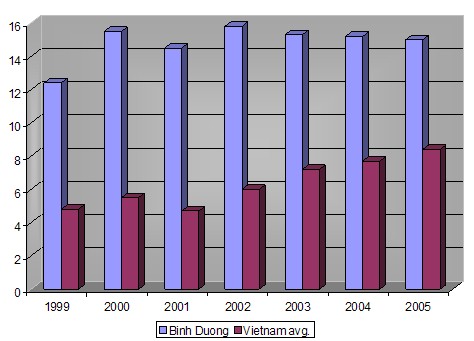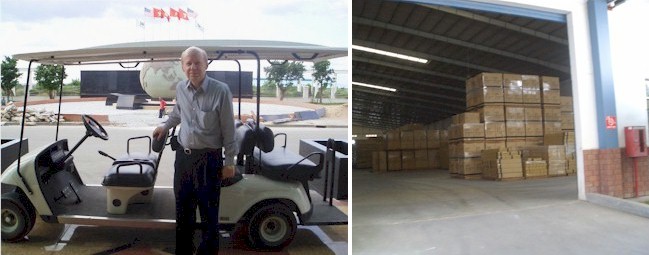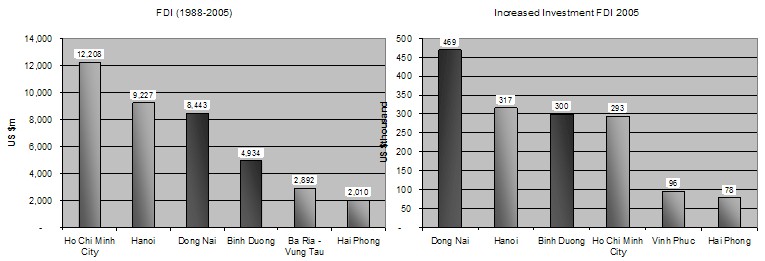
Binh Duong and Dong Nai – the Locomotives of Vietnam’s Economic Train
Gradually and with little fanfare, Vietnam is making its name known to the world not just because of prolonged wars, but also because of economic development and opportunities for those businesses seeking globalization. Vietnam’s efforts to relax market regulations started in the early 1990s but gained momentum with the signing and entry into force of the Bilateral Trade Agreement (BTA) with the U.S. in December, 2001 and more recently with the agreement on WTO accession for Vietnam. The opportunities created by these changes have attracted many foreign investors’ attention and dollars. Yet, still preoccupied with doubts about financial transparency, minor corruption and cumbersome red-tape, foreign investors usually prefer to spend extra time to perform their necessary due diligence and to narrow down an auspicious location on this 3000-km coastline country where they can dwell safely and their business can thrive. Further this influx of investors has gathered pace in 2006 as labor and other costs in China have continued to rise and also as U.S. and other multinationals have sought to diversify their sourcing and manufacture to alternate non-China locations to better spread risk and enhance their supply chains.
In this environment of growth in company start-ups and office openings, two names – Binh Duong and Dong Nai often are on company executives and start-up list plans. It is not surprising that after more than a decade since Vietnam opened the door for multinational enterprises, Binh Duong and Dong Nai provinces have become havens for foreign companies’ investment in Vietnam, only trailing Hanoi and Ho Chi Minh City.

Provincial Competitiveness Index: the leading seven provinces in 2005 and 2006
Source: Vietnam Chamber of Commerce and Industry
According to the Provincial Competitiveness Index (PCI) reports released by Vietnam Chamber of Commerce and Industry (VCCI) in 2005 and 2006, both Binh Duong and Dong Nai are in the top seven provinces that are most favorable to private sector dynamism and growth, with Binh Duong topping the chart in both years. The PCI is considered well-rounded as it was developed with international expertise and accounts for business establishment costs, land access and security of tenure, transparency and access to information, time costs and regulatory compliance, informal fees, competitive environment, provincial leadership, private sector development services, labor training, and legal institutions. The report shows that Binh Duong and Dong Nai performed consistently well on almost all aspects: they are two of the only three provinces that appear in the top seven in two consecutive years (Danang is the third and it is another province which we feel calls for increased foreign attention and investment). As the PCI is gaining credibility among the business sectors and economic organizations, foreign investors also refer to the PCI as an indicator for a healthy investing environment.
Both located at the south-eastern region of Vietnam, Binh Duong and Dong Nai share a few common factors that make them two of the four area that form the economic iron quadrangle in Vietnam. Abutting Ho Chi Minh City (HCMC) – the national hub of economic activities and transportation, Binh Duong and Dong Nai have the combined advantages of lower land and transportation costs compared to HCMC and adjacent areas. In addition, both provinces boast diversified geography, abundance in natural resources, good quality utilities and other infrastructure, adequate available labor and the favorable lack of natural disasters that help boost the two areas’ attractiveness to investors. Binh Duong and Dong Nai’s prosperity, nevertheless, cannot be solely accounted by natural advantages. As a matter of fact, these aspects were dismantled in PCI’s calculation.
Quoted in an interview with VietnamNet in September 30, 2005, Mr. Seth Winnick, the US Consular General in HCMC referred to Binh Duong and Dong Nai as “two of the most successful provinces in terms of economic development in Vietnam.” He also pointed out that other provinces in the same vicinity had been much less successful.
Contrary to many people’s belief that the Vietnamese market still is heavily centralized and subject to central government economic direction, each province has ample authority in determining its own investing environment and the incentives to attract investors, domestic and foreign alike. Consequently, the provinces and cities with forward looking and engaged political leadership usually result in increasing transparency for business ambiance, and hence, become havens to investors. Binh Duong and Dong Nai have undoubtedly made use of this opportunity to leverage their economic development.
Being the first province or city in the south-east region of Vietnam to build an industrial park, Dong Nai has maintained the reputation for innovation and effective economic leadership since then and has become the province with the largest number of industrial parks in Vietnam. Not self-satisfied with its successes, Dong Nai continually seeks to take advantage of the infrastructures and natural resources it possesses, as well as to augment the province’s socioeconomic development and competitive edge. The province’s Amata Industrial Park managed by the Thai Industrial Park company and located in land which once was part of a U.S. military base during the war years consistently attracts companies to build and expand factories to take of the park’s current park-like atmosphere of trees, greenery and high quality customer service.
Besides planning a thorough and sensible land distribution for various industry sectors, the provincial government of Dong Nai has achieved progress in simplifying regulations and providing extra incentives for investors. To complement the rapid development of industrial parks and increasing migration, Dong Nai also gives considerable focus to investment quality and supporting services. For instance, investment in healthcare and rural electrification programs has been increasing, and technology has been adapted widely to enhance services’ efficiency.
Like other provinces in the nation, Dong Nai still houses many state-owned enterprises (SOE). One of its goals is to complete the restructuring all these SOEs by the end of this year. The effect of these efforts at restructuring is already conspicuous after three years of process: the revenue of the restructured SOEs more than doubled, and their capital also rose significantly (according to Dong Nai’s website issued in May 9th 2006).
In addition to already-established industries such as food processing, mechanical fabrication, textile and garments, and woodworking and handicrafts, Dong Nai sketches out a clear strategy of pioneering in other sectors including automobiles, biotechnology, and IT. Education is also one of the province’s foci in an attempt to ensure a robust future. Understanding the infrastructure’s role in economic development, Dong Nai has structured the city meticulously with highways and bridges, turning itself into one of the largest transportation hubs of the region. For example, Thu Bien Bridge connecting Binh Duong and Dong Nai will be put into operation soon to promote both provinces’ economic development.
Binh Duong’s growth in recent years is no less striking. A young province (split from Song Be province in 1997), Binh Duong has proved its potential by accelerating to the first pace in the PCI chart. The provinces young age also appears to have acted in the province’s favor: as so far it has seemed to allow more flexibility in forming policies and structures. As a matter of fact, Binh Duong has performed impressively in the last eight years, showing GDP growth of 15% on average, double that of an average province in Vietnam.

GDP Growth rates
Source: Binh Duong Province website
Similar to Dong Nai, Binh Duong has a well thought out and well executed scheme for economic development, from building infrastructure to promoting education and training the workforce, from providing investment incentives to adapting the newest technology. Moreover, Binh Duong takes pride on a group of competent and shrewd leaders who have steered the provinces economy to success over the last years. According to Vietnam Economics News Online, Binh Duong has recently sent ten groups, including fifteen officials, abroad for training, research and attending international conferences. Mr. Nguyen Hoang Son, Chairman of Binh Duong’s People Committee, also noted in an interview with Vietnam Economics Times Online in June 2006 that Binh Duong officials meet as frequently as every week with entrepreneurs and investors to resolve any existing problems and to discuss issues of mutual concern. The province’s leadership’s willingness to stand on the investors’ side without unfairly bending the state’s regulations has won many investors’ hearts and more importantly pledges for further investment. Key industrial estates in the province such as Vietnam Singapore Industrial Park (VSIP) and Becamex’s My Phuoc Industrial Park (MPIP) continue to expand and attract numerous high quality foreign factories to locate in their parks. These well run parks house a wide range of industries including textiles, garments, wooden furniture, footwear plus consumer goods of all kinds.

(Picture left) the author, Mr. Christopher Runckel, President of Runckel & Associates, is seen at the entrance of
Kaiser Furniture (Vietnam) Co., Ltd in My Phuoc Industrial Park, Binh Duong and (right) their storage area
Statistics gathered by the Ministry of Planning and Investment (MPI) show that Dong Nai and Binh Duong rank third and fourth, respectively, in total FDI attraction from 1988 to 2005, regardless of Binh Duong’s status as a newly-established province. Furthermore, successful experience with Binh Duong and Dong Nai often leads foreign enterprises to increase their investment in the two provinces. In the same report, the MPI shows that Dong Nai ranks first and Binh Duong ranks third in increased FDI in 2005.

Source: Foreign Investment Department – Ministry of Planning and Investment
For all these reasons, former Prime Minister Phan Van Khai issued Decision number 146/2004/QĐ- TTg in 2004 naming Binh Duong and Dong Nai two of a few key cities for economic development of the southeastern region as well as the whole nation. Clearly, the two cities have not failed the government, investors, entrepreneurs of workers looking for increased employment, and still continue to carry the locomotive potential of the Vietnam economic train for both now and in the future.
About the Author:
Christopher W. Runckel, a former senior US diplomat who served in many counties in Asia, is a graduate of the University of Oregon and Lewis and Clark Law School. He served as Deputy General Counsel of President Gerald Ford’s Presidential Clemency Board. Mr. Runckel is the principal and founder of Runckel & Associates, a Portland, Oregon based consulting company that assists businesses expand business opportunities in Asia. (www.business-in-asia.com)
Until April of 1999, Mr. Runckel was Minister-Counselor of the US Embassy in Beijing, China. Mr. Runckel lived and worked in Thailand for over six years. He was the first permanently assigned U.S. diplomat to return to Vietnam after the Vietnam War. In 1997, he was awarded the U.S. Department of States highest award for service, the Distinguished Honor Award, for his contribution to improving U.S.-Vietnam relations. Mr. Runckel is one of only two non-Ambassadors to receive this award in the 200-year history of the U.S. diplomatic service.
